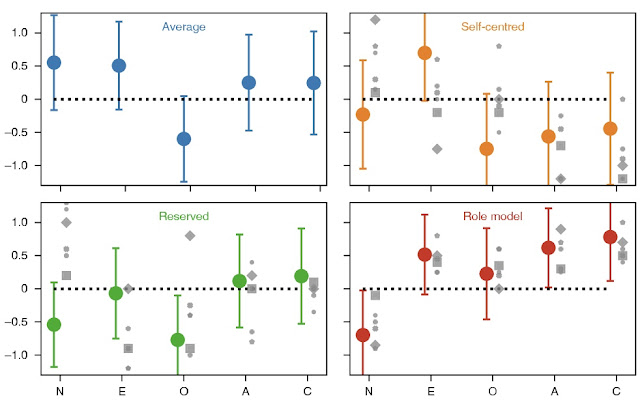Modeling personality for fiction
 |
| Neurotic, extraverted, open to experience, agreeable, conscientious. |
What follows is an over-simplified model of human personality based on these influences:
- This article on a study that identified four basic personality types: role-model, reserved, average, and self-centered. You can click the link for more, but I was attracted to this theory because it seems to be among the only theories that a scientist would call… you know, science.
- This video by LocalScriptMan on how the Enneagram is useful for writers if you cut all the B.S. and focus on the core idea that everyone has one of nine fundamental desires.
- Maslow’s hierarchy of needs… which seems to me to consist of more or less the same desires identified by the Enneagram, just in a different order.
This is not intended to be a model of personality for real human beings. Please try not to make one of those viral personality quizzes out of this. The point of this exercise is to help me quickly generate ideas for interesting fictional characters.
The benefit of my combined model is that you can derive how the character acts from what the character wants and vice-versa. It’s personality and motivation all-in-one.
Here’s the model in a nutshell. The four personality types are the same as those in the Gerlach et al. study, but they’re mapped to nine fundamental desires based on the Enneagram and Maslow’s hierarchy.
- Role-model: Idealism.
- Reserved: Identity, Mastery.
- Average: Dignity, Love, Belonging.
- Self-centered: Power, Stability, Pleasure.
Alright now let me unpack all that.
I. Role-models
Personality: Far more open to new experiences and new ways of doing things than the other types.
- A healthy role-model (a) believes their ideals can be achieved and (b) works toward them; they are considerate, confident, and outgoing.
- An unhealthy role-model either (a) believes their ideals cannot be achieved or (b) cannot work toward them; they take on the introversion of the reserved type and the anxiety of the average type. (See the Byronic hero.)
Motivation: Idealism. Where all the other types are motivated to do something for themselves, the role-model is motivated by a vision of (what they believe would be) a better society. Remember: If the character wants to change society to fulfill some personal need, they are not a role-model! For a role-model, changing society is an end unto itself.
Notes: Modernist genre fiction typically cast the heroes as role-models motivated by a vision for a better society and the villains as dull, self-centered types. Postmodernism has flipped this on its head: nearly every MCU superhero is self-centered and every villain has a warped vision of a better society.
II. Reserved types
Personality: Relatively introverted; this is the only type that more or less doesn’t need to be social to get what they want. A healthy reserved type has a quiet self-confidence; an unhealthy reserved type has a superiority complex and is bitter and inconsiderate toward others.
Motivation: Two possibilities:
- Identity. The desire to be an individual, to be different, to stand out, to be remembered. Typically aligns with aesthetic/artistic expression.
- Mastery. The desire to master a subject: to know all there is to know or to become the very best. Typically aligns with science or sports.
III. Average types
Personality: The most anxious type, because all their desires hinge directly upon pleasing others. Healthy average types are extraverted and manage their anxiety by communicating with others; unhealthy average types either (a) get overly attached or (b) let the anxiety take over.
Motivation: Three possibilities:
- Dignity. The desire to be valuable to society. An average type with this motivation has no sense of self-worth/esteem apart from how “productive” they are or how much they are helping their organization/society/community.
- Love. The desire to give and/or receive love, whether that be romantic, familial, or something more abstract (“I want to be loved by millions of fans!”).
- Belonging. The desire to belong to something bigger and more important than yourself; the desire to have guidance or someone who can decide what you should do with your life for you. Typically aligns with religious and/or cult-like thinking.
IV. Self-centered types
Personality: Inconsiderate toward others and highly extraverted. There’s not really a “healthy” self-centered type: they can either have a blind confidence in themselves or a deep-seated insecurity.
Motivation: Three possibilities:
- Power. The desire to have power over others for personal benefit. Typically rooted in the feeling, “I am under threat; I am not safe unless I have power.”
- Stability. The desire to have one’s basic needs (food, shelter, company, etc.) and to have them consistently, without having to struggle day in and day out.
- Pleasure. The desire to feel good and chase highs. Typically aligns with a hedonistic lifestyle, or at best a laid-back / always-on-vacation lifestyle.
Notes: There seems to be a lot of criticism of Maslow’s hierarchy of needs out there but the basic idea seems sound to me, with the caveat that psychological hangups seem to trap people in a lasting desire to chase “lower” needs that they already have.
So, how do I use this? Well, I’ve actually just binged all of LocalScriptMan’s videos and I’ve been having fun combining his theme-based method with these four personality types and something of a semiotic square. Basically, I come up with a theme and a reason that each of the four types would say each of the following four things…
- I approve because…
- I approve, but…
- I disapprove because…
- I disapprove, but…



Comments
Post a Comment